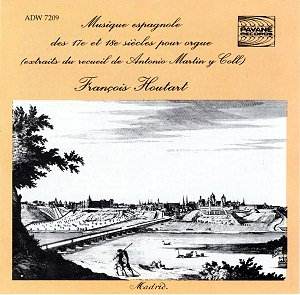|
|
Search MusicWeb Here |
|
 |
||
|
Founder:
Len Mullenger (1942-2025) Editor
in Chief:John Quinn
|
|
|
Search MusicWeb Here |
|
 |
||
|
Founder:
Len Mullenger (1942-2025) Editor
in Chief:John Quinn
|
 |
Musique espagnole des 17e et 18e siècles
pour orgue Antonio MARTIN y COLL (c1660-1735) Extraits de Flores de Musica 1 à 4 (1706-1709) Organ works by: 1. Anonyme: Obra de octavo tono, 2. Anonyme: Passacalles de primer tono, 3. Anonyme: Obra de segundo tono mana izquierda y dos bajos, 4. Anonyme: Obra de clarin, 5. Anonyme: Partido de mano derecha. Obra de tercer tono-Canción, 6. Diego XAVARA: Obra de lleno de tercer tono, 7. CAPOCIO: Gallarda, 8. Anonyme: Tiento de segundo tono por la mediacion, 9. Anonyme: Batalla famosa. François Houtart, Organist Organ by: Patrick Collon 1985, Church of Saint-Lambert, Brussels, Belgium Recorded: August 1989, Church of Saint-Lambert, Brussels, Belgium PAVANE RECORDS ADW 7209 [71’27’] |
| CD available for post-free online mail-order or you may download individual tracks. For some labels you can download the entire CD with a single click and make HUGE savings. The price you see is the price you pay! The full booklet notes are available on-line. | |
|
NOTE • Click on the button and you can buy the disc or read the booklet details • You can also access each track which you may then sample or down load. • Further Information. |
|
|
This CD presents Spanish music of ‘the golden age of Cabezon to the dawn of the 18th century’. These pieces were collected in four books, the Flores de Musica, by Antonio Martín y Coll. In these collections we find a musical evolution, enriched by ‘the travels of the musicians and the contacts between the courts of Brussels and Madrid’.
The booklet gives no more than the basic references but it is justified since very little is known about this music. Martín y Coll was a composer, organist and theoretician. He wrote two theoretical treatises ‘on the practice of liturgical music, in 1714 and 1734’ and also a collection of his own pieces, which is the fifth book of the Flores de Musica. Some of the pieces in the first four books of the collection were identified as that of Cabezon and surprisingly that of Frescobaldi too. The collection presents a variety of forms and styles, influenced by Italian, French or Dutch music. ‘Obras, Cancións, Passacalles, Chaconas and Batallas are juxtaposed with sacred pieces such as mass versets, hymns and Magnificats. The majority of the pieces are written on two staves of five lines, while some use the numerical Spanish tablature’, as the booklet inform us. The four Obras pieces of this CD follow the Ricercar form; the Partido and Tiento are types of accompanied recitative, whereas the Passacaglia, the Galliard and the Batalla are the less typically Spanish pieces. These pieces in spite of their stereotyped form, have many changes in rhythms and also a chromatic writing, which is not characteristic of the period. The most virtuoso and well-written pieces are those of Xavara and Capocio.
The organ used for this recording, according to the organ builder, ‘speaks Spanish with a Brussels accent’. It is a one-keyboard instrument, equipped with some aggressive reeds and gentle flue stops. The music though, would had been sounded much more in the style, if it had been recorded on a Spanish organ.
As this music is not the best ever written, it certainly demands full commitment from the player in order to sound at its best. Unfortunately, Houtart’s playing does not give the music the appropriate weight and significance at all. He plays without inspiration and as a result the music sounds boring and undifferentiated; this in spite of the different texture of the pieces. He lacks rhythmic clearance and an energetic articulation that would represent successfully the brilliance of certain pieces, such as the Obra de clarin or the Batalla famosa. His playing is not clear with a lot of slips all way through. In general, Houtart’s playing does not succeed in giving a fair account of this music, which is full of colour and variety in many aspects.
Christina Antoniadou |
| ADDITIONAL INFORMATION •
You can sample only 30 seconds (or 15% if that is longer) of a given track. Select from the View tracks list. Each sample will normally start from the beginning but you can drag the slider to any position before pressing play. • PLEASE NOTE: If you are behind a firewall and the sound is prematurely terminated you may need to register Ludwig as a trusted source with your firewall software.
•You will need Quicktime to hear sound samples. Get a free Quicktime download here • If you cannot see the "Sample All Tracks" button you need to download Flash from here.
|
|
|
Return to Index |